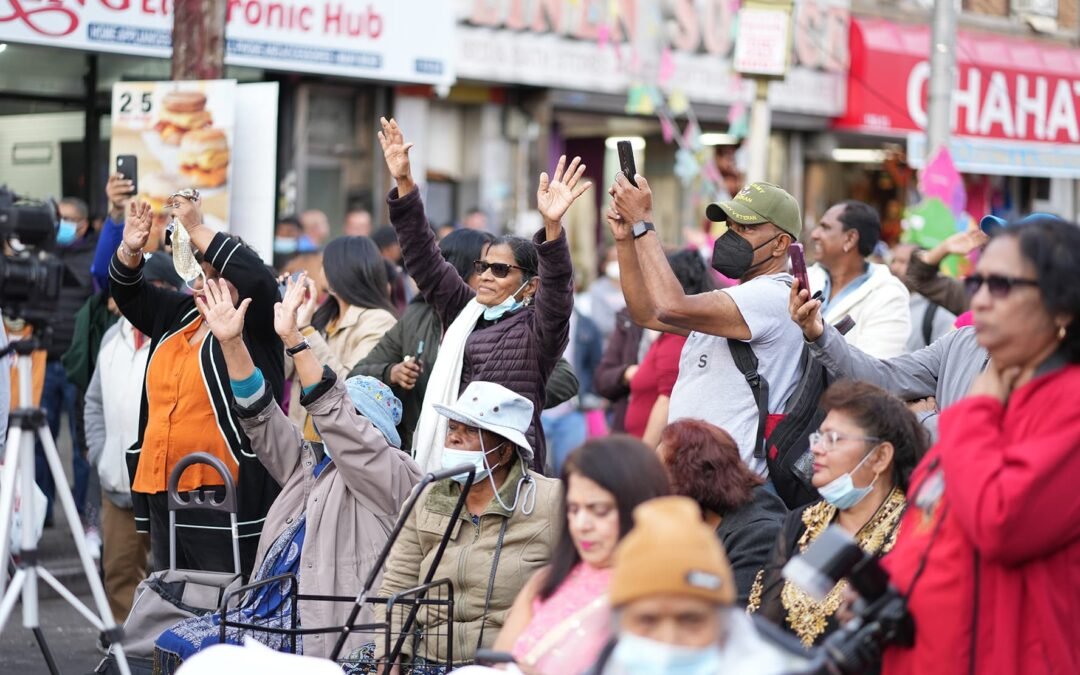 On Saturday, November 4, 2023, Liberty Avenue in Queens—co-named Little Guyana Avenue—blazed into evening as thousands gathered to watch the annual Diwali Motorcade roll past Lefferts Boulevard and through the Indo-Caribbean heart of Richmond Hill and Ozone Park. Crowds formed early, children waved paper diyas, elders clasped hands in prayer, and camera phones bobbed above a sea of smiles while the first illuminated floats inched forward to the thrum of Tassa drums. The night felt equal parts homecoming and public ritual, a neighborhood-wide affirmation that Diwali’s message of light over darkness belongs in the streets as much as it does in homes and mandirs.
On Saturday, November 4, 2023, Liberty Avenue in Queens—co-named Little Guyana Avenue—blazed into evening as thousands gathered to watch the annual Diwali Motorcade roll past Lefferts Boulevard and through the Indo-Caribbean heart of Richmond Hill and Ozone Park. Crowds formed early, children waved paper diyas, elders clasped hands in prayer, and camera phones bobbed above a sea of smiles while the first illuminated floats inched forward to the thrum of Tassa drums. The night felt equal parts homecoming and public ritual, a neighborhood-wide affirmation that Diwali’s message of light over darkness belongs in the streets as much as it does in homes and mandirs.
Devotion in Motion: Puja, Bhajans, and a Street-Side Satsang
Long before the motorcade settled into its glow, Liberty Avenue took on the hush of a shared puja. Families fixed small altar tableaux to dashboards—Lakshmi Maa seated on a lotus, Ganesh in gentle profile—while volunteers arranged marigold garlands, tea-lights, and incense on sidewalk stations. Between the bustle of setup came short invocations and blessings, the murmured rhythm of mantras, and call-and-response bhajans that pulled passersby into an improvised satsang. This devotional thread is part of what makes the Queens celebration distinct: it’s a street festival with a spiritual spine, where reverence and revelry live side by side and the symbolism of Diwali—knowledge dispelling ignorance—plays out in real time among neighbors and new friends.
Organizers and longtime devotees often describe the motorcade as a living lesson for the next generation. In 2023 that lesson was visible everywhere—toddlers peeking from stroller canopies, teens adjusting crowns and bangles, college students teaching younger cousins the words to familiar hymns. Against the neon and headlights, the oldest teachings felt newly accessible: light, shared; community, chosen; tradition, evolving.
The Floats: Rolling Shrines, Street Art, and Diaspora Design
The motorcade’s signature spectacle—its “floats”—is really a joyful catch-all for anything on wheels reimagined as art. In 2023 the range was dazzling. Some entries went grand: arches of PVC wrapped in warm LEDs; lotus blooms sculpted from foam and lit from within; sari swags engineered to ripple as pickups crept forward; framed portraits of deities outlined in mirror-work and gold leaf. Others were intimate: a family sedan crowned with a tiny diya mandir on the hood; a minivan whose roof carried an illuminated “Happy Diwali” panel; a flatbed turned temple stage where young dancers kept time to Tassa rhythms as the lights washed over them. The result was a moving gallery—a conversation between Caribbean carnival ingenuity and South Asian devotional aesthetics—that transformed Liberty Avenue into a gliding river of color.
Costumes deepened the pageantry. Children and teens personified Lakshmi, Saraswati, Rama, Sita, Krishna, and Kali with jeweled crowns, silk belts, and hand-painted props; elders pinned  brooches and adjusted pleats as the parade rolled past storefronts perfumed with mithai and roti. Even spectators became part of the show: one block sang along to a film-song medley while another answered a bhajan’s refrain with a soft, synchronized clap. By the time the leading vehicles reached Lefferts, the boundary between audience and procession had thinned to a celebration shared, not merely watched.
brooches and adjusted pleats as the parade rolled past storefronts perfumed with mithai and roti. Even spectators became part of the show: one block sang along to a film-song medley while another answered a bhajan’s refrain with a soft, synchronized clap. By the time the leading vehicles reached Lefferts, the boundary between audience and procession had thinned to a celebration shared, not merely watched.
Stages That Breathe: Singing, Dancing, Tassa & Sitar
Throughout the afternoon and into night, curbside stages stitched the route together with a rotating program of song and dance. Tassa troupes laid down that unmistakable brass-rim thunder—the heartbeat of Indo-Caribbean celebration—while classical and semi-classical dancers moved from precise mudras to spinning crescendos. A sitar segment threaded quiet through the crowd just long enough for the street to catch its breath; moments later, a film-song medley turned the pavement into a dance floor where teenagers, aunties, and visiting cousins tried the same chorus step from three different decades. The programming didn’t feel like filler between floats; it felt like the city speaking back to a tradition in the vernacular of performance.
If Tassa provided the rhythm, the voices supplied the arc. Singers carried devotional lyrics over the traffic hush, then flipped to beloved Bollywood classics without losing thread or pitch. The effect was an emotional braid—joy to reverence, reverence back to joy—moving with the procession’s pace. Every few minutes a new entry or act arrived, and with it a fresh wave of cheers, phone flashes, and the clatter of vendors lifting foil on hot trays for families that had been on their feet since afternoon.
Place Matters: Liberty Avenue, Little Guyana, and a City That Makes Room
 The celebration’s setting is more than backdrop. Liberty Avenue is a long east–west ribbon across Brooklyn and Queens, but the South Richmond Hill stretch has a singular identity: Indian clothing and jewelry shops, puja stores, bakeries perfumed with pine tarts and salara, and a constellation of mandirs and mosques. In May 2021, the city recognized this lived reality by co-naming the corridor “Little Guyana Avenue,” honoring the Indo-Guyanese and Indo-Trinidadian communities that made the neighborhood their own. On motorcade night that identity is audible—the intermingled accents, the playground Creole, the Hindi and Bhojpuri refrains, the laughter that travels half a block before you see who’s laughing. It is also visible, preserved in the pride of shopkeepers and elders who remember what it took to stitch temples and small businesses into a civic fabric strong enough to carry a parade of lights.
The celebration’s setting is more than backdrop. Liberty Avenue is a long east–west ribbon across Brooklyn and Queens, but the South Richmond Hill stretch has a singular identity: Indian clothing and jewelry shops, puja stores, bakeries perfumed with pine tarts and salara, and a constellation of mandirs and mosques. In May 2021, the city recognized this lived reality by co-naming the corridor “Little Guyana Avenue,” honoring the Indo-Guyanese and Indo-Trinidadian communities that made the neighborhood their own. On motorcade night that identity is audible—the intermingled accents, the playground Creole, the Hindi and Bhojpuri refrains, the laughter that travels half a block before you see who’s laughing. It is also visible, preserved in the pride of shopkeepers and elders who remember what it took to stitch temples and small businesses into a civic fabric strong enough to carry a parade of lights.
For newcomers, the geography helps. The A train delivers attendees to Lefferts; side streets become viewing stands; the route’s steady pace lets families join for a block or two, then circle back for food and photos. Kids buzz with the thrill of recognizing deities on floats they’ve only seen on posters; grandparents, seeing those same images reframed by LEDs and afrosheen, chuckle at how Diwali can be both exactly the same and entirely new. In Queens, that paradox is a feature, not a flaw. The borough’s diversity is not simply a statistic—it’s an invitation to participate, to witness, and, if you feel so moved, to clap along on the two and the four.
Why 2023 Felt Different: A Holiday Recognized, A Tradition Renewed
The 2023 motorcade unfolded the same week New York City public schools first recognized Diwali as an official holiday, a milestone that rippled through conversations on the avenue. Parents spoke about visibility; teachers, about the gift of time to celebrate; kids, about feeling “counted.” That recognition didn’t change the core of the festival—lamps were already lit, songs already learned—but it reframed how the city hears them. A parade long cherished within a diaspora suddenly felt legible to a wider public, a cue for neighbors to learn, greet, and join. The glow wasn’t just from LEDs; it was civic, coming from a city that had, at least in one concrete way, made room for the light.
In the diaspora, tradition evolves without apology. In Queens, devotional art borrows stagecraft from soca and Bollywood; floats are engineered with hardware-store ingenuity; and sacred story is told by teenagers who slip from Ramayana poses to TikTok steps without contradiction. That blending is not dilution—it is transmission. What 2023 proved once again is that the Diwali Motorcade is not merely a memory of elsewhere; it is a living practice here, fully New York in its openness and fully Indo-Caribbean in its soul. When the last float turned, families began the slow walk home with boxes of sweets tucked under arms and the sound of Tassa fading down the block. In the cooling air, the scent of incense lingered like a benediction.
Editor’s Note & References
Date, place, and contextual details for the 2023 motorcade are drawn from on-scene reporting and public posts documenting the Queens celebration; links are provided below for reference.
• Religion News Service feature on the 2023 Queens Diwali Motorcade, including date, location, and community context.
• YouTube street-level footage from Liberty Avenue during the 2023 celebration.
• Additional 2023 videos from Liberty Avenue showing floats, performances, and crowd views.
• Background on Liberty Avenue and the Little Guyana Avenue co-naming (May 29, 2021).

